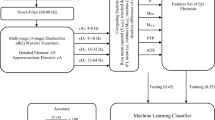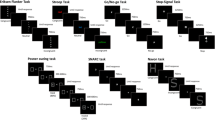Abstract
People can learn to control mu (8–12 Hz) or beta (18–25 Hz) rhythm amplitude in the EEG recorded over sensorimotor cortex and use it to move a cursor to a target on a video screen. In our current EEG-based brain–computer interface (BCI) system, cursor movement is a linear function of mu or beta rhythm amplitude. In order to maximize the participant's control over the direction of cursor movement, the intercept in this equation is kept equal to the mean amplitude of recent performance. Selection of the optimal slope, or gain, which determines the magnitude of the individual cursor movements, is a more difficult problem. This study examined the relationship between gain and accuracy in a 1-dimensional EEG-based cursor movement task in which individuals select among 2 or more choices by holding the cursor at the desired choice for a fixed period of time (i.e., the dwell time). With 4 targets arranged in a vertical column on the screen, large gains favored the end targets whereas smaller gains favored the central targets. In addition, manipulating gain and dwell time within participants produces results that are in agreement with simulations based on a simple theoretical model of performance. Optimal performance occurs when correct selection of targets is uniform across position. Thus, it is desirable to remove any trend in the function relating accuracy to target position. We evaluated a controller that is designed to minimize the linear and quadratic trends in the accuracy with which participants hit the 4 targets. These results indicate that gain should be adjusted to the individual participants, and suggest that continual online gain adaptation could increase the speed and accuracy of EEG-based cursor control.
Similar content being viewed by others
REFERENCES
Farwell, L. A., & Donchin, E. (1988). Talking off the top of your head: Toward a mental prosthesis utilizing event-related brain potentials. Electroencephalography and Clinical Neurophysiology, 70, 510-523.
Gastaut, H. (1952). Etude electrocorticographique de la reactivite des rythmes rolandiques. Revenue Neurology, 87, 76-182.
Kuhlman, W. N. (1978). EEG feedback training: Enhancement of somatosensory cortical activity. Electroencephalography and Clinical Neurophysiology, 45, 290-294.
Levine, S. P., Huggins, J. E., BeMent, S. L., Kushwaha, R. K., Schuh, L. A., Rohde, M. M., et al. (2000). A direct brain interface based on event-related potentials. IEEE Transactions on Rehabilitation Engineering, 8, 180-185.
Marple, S. L. (1987). Digital spectral analysis with applications. Englewood Cliffs, NJ: NewJersey, Prentice-Hall.
McFarland, D. J., Lefkowicz, T., & Wolpaw, J. R. (1997). Design and operation of an EEG-based brain-computer interface (BCI) with digital signal processing technology. Behavioral Research Methods, Instruments, and Computers, 29, 337-345.
McFarland, D. J., McCane, L. M., David, S. V., & Wolpaw, J. R. (1997). Spatial filter selection for EEG-based communication, Electroencephalography and Clinical Neurophysiology, 103, 386-394.
McFarland, D. J., McCane, L. M., & Wolpaw, J. R. (1998). EEG-based communication and control: Short-term role of feedback. IEEE Transactions on Rehabilitation Engineering, 6, 7-11.
McFarland, D. J., Neat, G. W., Read, R. F., & Wolpaw, J. R. (1993). An EEG-based method for graded cursor control. Psychobiology, 21, 77-81.
Miner, L. A., McFarland, D. J., & Wolpaw, J. R. (1998). Answering questions with an electroencephalogram-based brain-computer interface. Archives of Physical Medicine and Rehabilitation, 79, 1029-1033.
Perelmouter, J., & Birbaumer, N. (2000). A binary spelling interface with random errors. IEEE Transactions on Rehabilitation Engineering, 8, 227-232.
Pierce, J. R. (1980). An introduction to Information Theory. (pp. 145-165). New York: Dover.
Pfurtscheller, G., & Berghold, A. (1989). Patterns of cortical activation during planning of voluntary movement. Electroencephalography and Clinical Neurophysiology, 72, 250-258.
Pfurtscheller, G., Flotzinger, D., & Kalcher, J. (1993). Brain-computer interface—A new communication device for handicapped persons. Journal of Microcomputer Applications, 16, 293-299.
Press, W. H., Teukolsky, S. A., Vetterling, W. T., & Flannery, B. P. (1992). Numerical recipes in C: The art of scientific computing (2nd ed.). New York: Cambridge University Press.
Ramoser, H., Wolpaw, J. R., & Pfurtscheller, G. (1997). EEG-based communication: Evaluation of alternative signal prediction methods. Biomedizinische Technik, 42, 226-233.
Shannon, C. E., & Weaver, W. (1964). The mathematical theory of communication. Urbana: University of Illinois Press.
Sharbrough, F., Chatrian, C. E., Lesser, R. P., Luders, H., Nuwer, M., & Picton, T. W. (1991). American Electroencephalographic Society guidelines for standard electrode position nomenclature. Journal of Clinical Neurophysiology, 8, 200-202.
Sutter, E. E. (1992). The brain response interface: Communication through visually guided electrical brain responses. Journal of Microcomputer Applications, 15, 31-45.
Winer, B. J. (1971). Statistical principals in experimental design. New York: McGraw-Hill.
Wolpaw, J. R., McFarland, D. J., & Cacace, A. T. (1986). Preliminary studies for a direct brain-to-computer parallel interface. In Projects for persons with disabilities, IBM Technical Symposium (pp. 11-20). White Plains, NY: IBM.
Wolpaw, J. R., McFarland, D. J., Neat, G. W., & Forneris, C. A. (1991). An EEG-based brain-computer interface for cursor control. Electroencephalography and Clinical Neurophysiology, 78, 252-259.
Wolpaw, J. R., & McFarland, D. J. (1994). Multichannel EEG-based brain-computer communication. Electroencephalography and Clinical Neurophysiology, 90, 444-449.
Author information
Authors and Affiliations
Corresponding author
Rights and permissions
About this article
Cite this article
McFarland, D.J., Wolpaw, J.R. EEG-Based Communication and Control: Speed–Accuracy Relationships. Appl Psychophysiol Biofeedback 28, 217–231 (2003). https://doi.org/10.1023/A:1024685214655
Issue Date:
DOI: https://doi.org/10.1023/A:1024685214655




